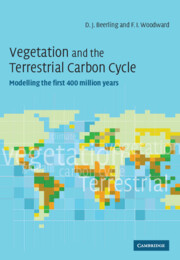Book contents
- Frontmatter
- Contents
- Preface
- Acknowledgements
- 1 Introduction
- 2 Investigating the past from the present
- 3 Climate and terrestrial vegetation
- 4 Climate and terrestrial vegetation of the present
- 5 The late Carboniferous
- 6 The Jurassic
- 7 The Cretaceous
- 8 The Eocene
- 9 The Quaternary
- 10 Climate and terrestrial vegetation in the future
- 11 Endview
- References
- Index
3 - Climate and terrestrial vegetation
Published online by Cambridge University Press: 09 August 2009
- Frontmatter
- Contents
- Preface
- Acknowledgements
- 1 Introduction
- 2 Investigating the past from the present
- 3 Climate and terrestrial vegetation
- 4 Climate and terrestrial vegetation of the present
- 5 The late Carboniferous
- 6 The Jurassic
- 7 The Cretaceous
- 8 The Eocene
- 9 The Quaternary
- 10 Climate and terrestrial vegetation in the future
- 11 Endview
- References
- Index
Summary
Introduction
Assemblages of species of plants constitute vegetation. At any location, the type of vegetation, in terms of its structure and its functioning, is dependent on both the constituent species and the environment of the vegetation. The natural environment can be considered to encompass the long term climate and the underlying soil conditions. Increasingly, we see that the present-day environment of vegetation is being influenced by human controlled disturbances. These disturbances, such as vegetation clearance for food and fuel, for urbanisation and for agriculture constitute the total environment of vegetation. Human impacts on the carbon cycle are considered in Chapter 10.
The primary emphasis of this book is on the effects of changes in climate on the distribution and functioning of vegetation, since the first emergence of land plants about 450 million years ago. The two components needed to investigate the functioning of vegetation over the last 450 Ma are the climatic constraints on plant and vegetation functioning and the climatic conditions in which plants occur. In addition, it is important to recognise that investigating and modelling the activity of past vegetation assumes that the basic plant processes, as we understand them for the present day, such as photosynthesis, respiration, transpiration and nutrient uptake, are equally valid for earlier times, an issue already discussed in Chapter 2.
Palaeoclimatic records are not like simple mercury thermometers but depend on sophisticated analyses of fossil plant and rock material.
- Type
- Chapter
- Information
- Vegetation and the Terrestrial Carbon CycleThe First 400 Million Years, pp. 23 - 52Publisher: Cambridge University PressPrint publication year: 2001



